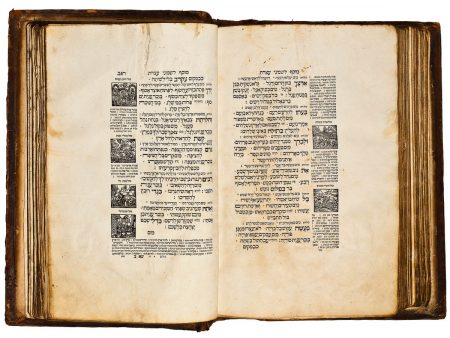Mahzor ke-Minhag Ashkenazim
Ever since the beginning of printing, deluxe copies of Hebrew books have been issued on parchment. In the case of some incunable editions, such as the 1482 Bologna Pentateuch, more parchment than paper copies remain. After the invention of printing the reader’s “idea” of a book may have continued to be that of a handwritten volume on parchment. The durability of parchment relative to paper, and the fact that parchment was venerated as the carrier of Torah scrolls may also have played a role in the selection of this material. In the course of the sixteenth century printing on parchment became a bibliophilistic eccentricity, similar to the printing of “secondary deluxe” copies on tinted, mostly blue paper.
After the popularity of parchment copies decreased somewhat during the seventeenth century, the most important Jewish bibliophile of the premodern Jewish world, David ben Abraham Oppenheim (or Oppenheimer; 1664–1736) of Prague, breathed new life into the phenomenon. He ordered special copies of Hebrew books from printing houses in the most important centers of Hebrew printing, including Sulzbach, Bavaria. There is a connection between the famous Oppenheimer family of Viennese Court Jews, to which David Oppenheim also belonged,
and the originally Viennese printer Aaron ben Uri Lipmann Fränkel. Mendel Oppenheimer (1657–1721) and Samson Wertheimer (1658–1724) of Vienna facilitated the production of this, Fränkel’s second Sulzbach edition of the mahzor, as they ordered and paid for thirteen copies on parchment, for 100 thaler each. The Braginsky copy, one of these thirteen, has an ownership entry of Josel Wertheimer (ca. 1626– 1713) on both title pages.
The mahzor contains many woodcut initial letters and initial word panels, as well as two series
of woodcut illustrations of the signs of the zodiac. Already in medieval mahzorim these often accompanied the prayers for dew and for rain, recited during the Musaf service on the first day of Passover (here in volume one) and the Musaf service on the eighth day of Sukkot (Shemini Atzeret; volume two). On folios 281v and 282r of the second volume Virgo, Libra, Scorpio, Sagittarius, Capricorn, and Aquarius appear. [ES]
selected literature
Freimann, 1911, no. 108; Hill, 1996, p. 206; Weinberg, 1903, p. 48, pp. 132–133, no. 53.
Mahzor ke-Minhag Ashkenazim (Festival Prayer Book According to the Ashkenazic Rite)
Sulzbach, printed by Aaron ben Uri Lippmann Fränkel, 1709
Parchment, two volumes, 1: 255 leaves, 420 × 260 mm (16.5 × 10.2 in.), modern leather binding, 2: 307 leaves, lacking fol. 242, substituted in manuscript (verso blank), 412 × 270 mm (16.2 × 10.6 in.), old leather binding
Braginsky Collection 279
